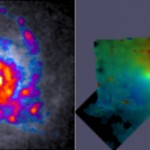W. M. Keck Observatory press release…
A team of Australian researchers used two Maunakea-based observatories – Gemini North and W. M. Keck Observatory – to discover why some galaxies are clumpy rather than spiral in shape and it appears that low spin is to blame. The finding challenges an earlier theory that high levels of gas cause clumpy galaxies, and sheds light on the conditions that brought about the birth of most of the stars in the Universe. The finding was published today in The Astrophysical Journal.

A combination of integral field spectroscopy data from Keck Observatory and Gemini Observatory was the key to obtaining measurements for a galaxy’s spin. Keck Observatory’s OSIRIS instrument collected data high spatial resolution in the galaxy centers, and the Gemini Multi-Object Spectrograph (GMOS) collected data for high surface brightness sensitivity out to large radii.
Lead author Dr. Danail Obreschkow, from The University of Western Australia (UWA) node of the International Centre for Radio Astronomy Research (ICRAR), said that ten billion years ago the Universe was full of clumpy galaxies, but these developed into more regular objects as they evolved; the majority of stars in the sky today, including our five billion-year-old Sun, were probably born inside these clumpy galaxies.
Continue reading “Mauna Kea Observatories Put New Spin on Galaxy Formation”
